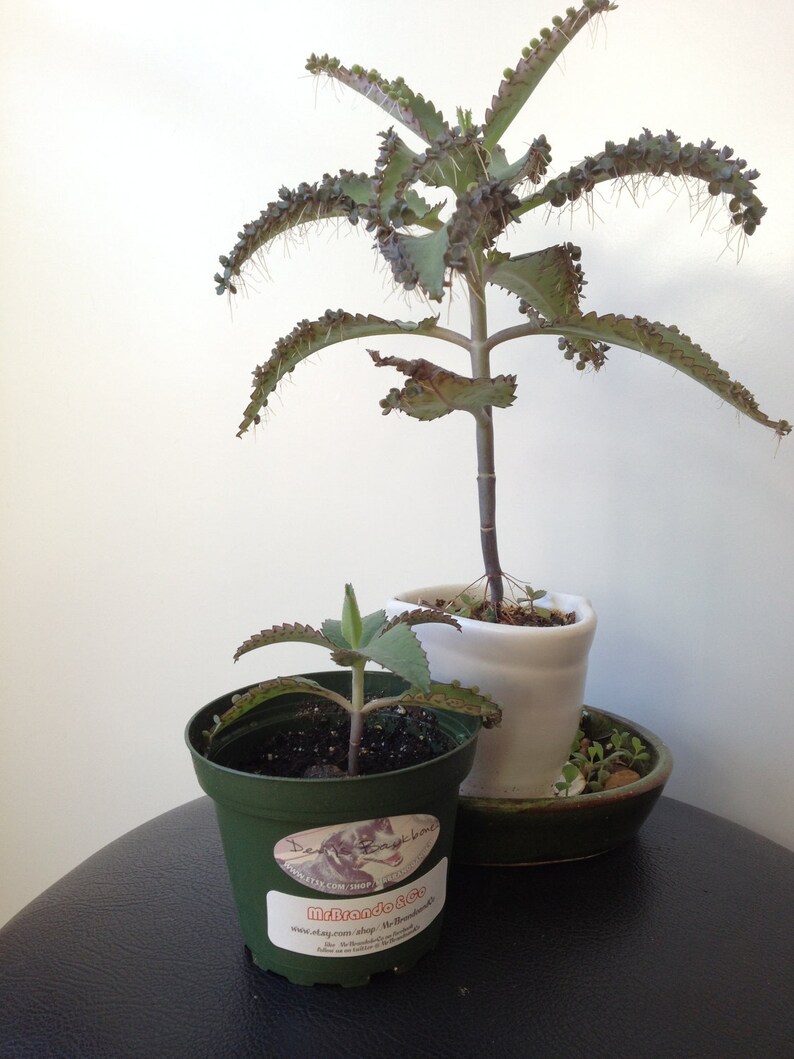

New leaves pair up 90 degrees away from the older ones, enabling all leaves to have good access to sunlight. As the plant grows, each pair of leaves is staggered directly opposite the other. Large, bluish-green leaves with pointed tips grow in pairs from the stem. While mother of thousands does produce flowers, they’re a strange greyish-pink color instead of bright and cheerful. After all, most kalanchoe plants are prized for their unique and unusual flowers. While calling it Kalanchoe daigremontiana isn’t necessarily a bad thing, it does confuse matters. However, it’s now referred to as Kalanchoe daigremontiana. Technically, its botanical name was Bryophyllum daigremontiana. There’s been some confusion about the botanical name for this Madagascar native plant. Well draining sandy soil, like a cactus and succulent mixĪphids, mealybugs, scale insects, root rotĪll About the Mother Of Thousands In an outdoor bed, it can rapidly self-sow if one doesn’t remain attentive. Mexican hat plant, devil’s backbone, alligator plant, mother of thousandsīright, indirect lighting (6+ hours per day) Quick Care Guide Mother of thousands is an unusual succulent to grow. Hoffman Organic Cactus & Succulent Soil Mix.ISBN 978-0-89672-614-7.Good Products At Amazon For Growing Bryophyllum Daigremontiana: Weeds in South Texas and Northern Mexico. "Impact of two invasive succulents on native-seedling recruitment in Neotropical arid environments". ^ Herrera, Ileana Ferrer-Paris, José R."Morphogenesis of propagules in viviparous species Bryophyllum daigremontianum and B. "An investigation of the cultivated Kalanchoe daigremontiana group, with a checklist of Kalanchoe cultivars" (PDF). "Poisoning of cattle by Bryophyllum plants". "New Bufadienolides from Kalanchoe daigremontiana Hamet et Perr. ^ Wagner, Hildebert Fischer, Manfred Lotter, Hermann (1985).^ a b " Kalanchoe daigremontiana Raym.-Hamet & H.Perrier".The plant is not frost-hardy and typically dies in places where temperatures are below freezing. During growth periods with higher temperatures and increased water supply, this species requires proper nutrition, without which leaves show deficiency symptoms such as crippled growth and pustule-like lesions. daigremontiana can survive prolonged periods of drought with little or no water. Indoor plants, as well as balcony plants which have been moved inside to survive the cold season, begin flowering in early winter.Īs a succulent plant, K. Particularly in climates with distinct seasonal temperature differences, flowering is most frequently observed at the beginning of a warm season. Flowering is, however, not an annual event and occurs sporadically if at all on some shoots. Kalanchoe daigremontiana has an umbrella-like terminal inflorescence (a compound cyme) of small bell-shaped, grayish pink (or sometimes orange) flowers. Kalanchoe daigremontiana can spread by both seeds and by plantlets dropped from its leaves. Then the lateral roots may enter soil and new vertical shoots may grow from the original shoot. A plant's upper leaves may grow large, causing its main stalk to bend downward. Ī plant may also develop lateral roots on its main stalk, as high up as 10–15 cm (3.9–5.9 in) above the ground. Leaf margins have spoon-shaped bulbiliferous spurs which bear plantlets which may form roots while still attached to leaves. They are green above and blotched with purple underneath. Plants grow up to 1 m (3 ft 3 in) tall and have opposite and whorled, fleshy oblong- lanceolate leaves which grow up to 20 cm (8 in) long and 32 mm ( 1 + 1⁄ 4 in) wide. daigremontiana has strongly cordate to auriculate or even peltate leaves. daigremontiana, and its leaf base is attenuate, cuneate to weakly cordate or auriculate, while K. delagoensis, therefore has characteristics in between its leaves are narrower than those of K.

daigremontiana has lanceolate, oblong, ovate or triangular leaves. daigremontiana has bands or spots on the back of leaves. laetivirens are completely green, while K. All parts of this species contain a very toxic steroid known as daigremontianin. Like other members of Bryophyllum (now included in the genus Kalanchoe), it can propagate vegetatively from plantlets that develop on its leaf margins, as well as through upshoots from lateral roots, and seeds. Kalanchoe daigremontiana, formerly known as Bryophyllum daigremontianum and commonly called mother of thousands, or Mexican hat plant, is a succulent plant native to Madagascar. Bryophyllum daigremontianum (Raym.-Hamet & H.Perrier) A.Berger.


 0 kommentar(er)
0 kommentar(er)
